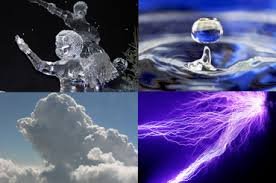
New type of matter that’s solid AND liquid at the same time
Until now, the atoms in physical material were understood to exist typically in one of three states – solid, liquid or gas.
Using what’s known as a neural network—an artificial intelligence machine that learns how to predict behavior based on prior examples. After being trained on small groups of potassium atoms, the neural network learned quantum mechanics well enough to simulate collections containing tens of thousands of atoms.
The computer models confirmed that between about 20,000 and 40,000 times atmospheric pressure and 400 to 800 Kelvin (260 to 980 degrees Fahrenheit), the potassium entered what’s called a chain-melted state, in which the chains dissolved into liquid while the remaining potassium crystals stayed solid.
This is the first time scientists have shown that such a state is thermodynamically stable for any element.
The machine learning technique that the team developed could be useful in modeling the behavior of other substances.
SOLID, LIQUID, GAS … and something else? While most of us learn about just three states of matter in elementary school, physicists have discovered several exotic varieties that can exist under extreme temperature and pressure conditions.
Now, a team has used a type of artificial intelligence to confirm the existence of a bizarre new state of matter, one in which potassium atoms exhibit properties of both a solid and a liquid at the same time. If you were somehow able to pull out a chunk of such material, it would probably look like a solid block leaking molten potassium that eventually all dissolved away.
“It would be like holding a sponge filled with water that starts dripping out, except the sponge is also made of water,”
The unusual state of potassium could exist under conditions found in Earth’s mantle, but the element is generally not found in a pure form and is usually bound up with other material. Similar simulations could help study the behaviors of other minerals in such extreme environments.
Metals like potassium are fairly straightforward on a microscopic level. When shaped into a solid bar, the element’s atoms link up into orderly rows that conduct heat and electricity well. For a long time, researchers believed that they could easily predict what might occur to such crystalline structures under pressure.
But around 15 years ago, scientists discovered that sodium—a metal with similar properties to potassium—did something strange when compressed. At 20,000 times the pressure present at the Earth’s surface, sodium transformed from a silvery block into a transparent material, one that did not conduct electricity but rather prevented its flow. By probing the sodium with x-rays, scientists could see that its atoms had adopted a complex crystal formation instead of a simple one.
Our nights are getting brighter, and Earth is paying the price
Potassium, too, has been subjected to much experimental scrutiny. When compressed to similar extremes, its atoms arrange themselves into an elaborate formation—five cylindrical tubes organized into an X shape, with four long chains sitting in the crooks of this assembly, almost like two separate and non-intertwining materials.
“Somehow, these potassium atoms decide to divide up into two loosely linked sub-lattices,” But as scientists turned up the heat, x-ray images showed the four chains disappearing, and researchers argued about what exactly was happening.
“Most of the matter in the universe is at high pressure and temperature, for instance inside planets and stars.
Hi! I am a robot. I just upvoted you! I found similar content that readers might be interested in:
https://www.youtube.com/watch?v=OUjNbq5nCIADownvoting a post can decrease pending rewards and make it less visible. Common reasons:
Submit
Congratulations @w3tube! You received a personal award!
You can view your badges on your Steem Board and compare to others on the Steem Ranking
Do not miss the last post from @steemitboard:
Vote for @Steemitboard as a witness to get one more award and increased upvotes!
Downvoting a post can decrease pending rewards and make it less visible. Common reasons:
Submit